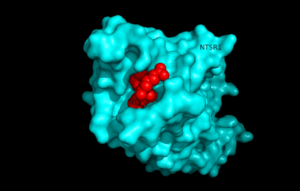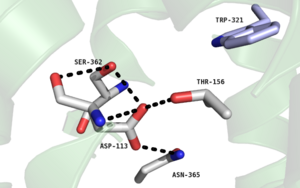Sandbox Reserved 1176
From Proteopedia
(Difference between revisions)
| Line 36: | Line 36: | ||
====Phe358==== | ====Phe358==== | ||
| - | When this residue was mutated to an alanine <ref name="SPGP"/> the <scene name='72/721547/Hydrophobic_binding_pocket/5'>hydrophobic stacking interactions</scene> of the ligand binding pocket were interrupted,resulting in a lack of G-Protein activity in NTSR1.<ref name="SPGP"/>.This supported the role of Phe358 as stated in the hydrophobic binding pocket section of this page. | + | When this residue was mutated to an alanine <ref name="SPGP"/> the <scene name='72/721547/Hydrophobic_binding_pocket/5'>hydrophobic stacking interactions</scene> of the ligand binding pocket were interrupted,resulting in a lack of G-Protein activity in NTSR1.<ref name="SPGP"/>.This supported the role of Phe358 as stated in the hydrophobic binding pocket section of this page. |
====Glu166==== | ====Glu166==== | ||
| - | Although the role of <scene name='72/721548/E166/3'>Glu166</scene> in G-protein activity is not quite as clear as it is for <scene name='72/721548/L310/3'>Leu310</scene> or <scene name='72/721547/Hydrophobic_binding_pocket/5'>Phe358</scene>, substituting this residue for an alanine significantly reduced catalytic nucleotide exchange <ref name="SPGP"/>. Glu166 is part of a D/ERY motif that is highly conserved in class A GPCRs and includes Arg167 and Tyr168. To determine a role for Glu166, other class A GPCRs were structurally analyzed. Researchers <ref name="SPGP"/> hypothesize that E166 in NTSR1 interacts with Val102, Thr101,and weakly interacts with His105 to stabilize the G protein. Researchers <ref name="SPGP"/> have also noted the possibility of an important connection between the D/ERY motif and intracellular loop 2, which plays a role in the dissociation of the receptor-G protein complex with GTP present. M181 is believed to link the D/ERY motif and ICL2. <ref name="SPGP"/> | + | Although the role of <scene name='72/721548/E166/3'>Glu166</scene> in G-protein activity is not quite as clear as it is for <scene name='72/721548/L310/3'>Leu310</scene> or <scene name='72/721547/Hydrophobic_binding_pocket/5'>Phe358</scene>, substituting this residue for an alanine significantly reduced '''[https://en.wikipedia.org/wiki/Active_site catalytic]''' nucleotide exchange <ref name="SPGP"/>. Glu166 is part of a D/ERY motif that is highly conserved in class A GPCRs and includes Arg167 and Tyr168. To determine a role for Glu166, other class A GPCRs were structurally analyzed. Researchers <ref name="SPGP"/> hypothesize that E166 in NTSR1 interacts with Val102, Thr101,and weakly interacts with His105 to stabilize the G protein. Researchers <ref name="SPGP"/> have also noted the possibility of an important connection between the D/ERY motif and intracellular loop 2, which plays a role in the dissociation of the receptor-G protein complex with GTP present. M181 is believed to link the D/ERY motif and ICL2. <ref name="SPGP"/> |
== Biological Relevance == | == Biological Relevance == | ||
===Neurotensin=== | ===Neurotensin=== | ||
| - | <scene name='72/721548/Neurotensin/3'>Neurotensin</scene> is a 13 amino acid peptide that is found in both nervous and peripheral tissues. It functions as a '''[https://en.wikipedia.org/wiki/Hormone hormone]''' and a '''[https://en.wikipedia.org/wiki/Neurotransmitter neurotransmitter]''' by activating the G-protein coupled receptor NTSR1<ref name= "SPGP"/> | + | <scene name='72/721548/Neurotensin/3'>Neurotensin</scene> is a 13 amino acid '''[https://en.wikipedia.org/wiki/Peptide peptide]''' that is found in both '''[https://en.wikipedia.org/wiki/Nervous_tissue nervous]''' and peripheral tissues. It functions as a '''[https://en.wikipedia.org/wiki/Hormone hormone]''' and a '''[https://en.wikipedia.org/wiki/Neurotransmitter neurotransmitter]''' by activating the G-protein coupled receptor NTSR1<ref name= "SPGP"/> |
===Leptin Research=== | ===Leptin Research=== | ||
| - | NTSR1 deficient mice were not able to receive a satiety signal.<ref name="Mice"/>The mice continued to eat when food was present, leading to significant weight gain. This relationship between satiety and NTS is related to the involvement of NTSR1 in the signaling pathway for '''[https://en.wikipedia.org/wiki/Leptin Leptin]''' and therefore food intake. Without sufficient NTSR1 this pathway is interrupted. <ref name="Mice"/> | + | NTSR1 deficient mice were not able to receive a '''[https://en.wikipedia.org/wiki/Hunger_(motivational_state) satiety]''' signal.<ref name="Mice"/>The mice continued to eat when food was present, leading to significant weight gain. This relationship between satiety and NTS is related to the involvement of NTSR1 in the signaling pathway for '''[https://en.wikipedia.org/wiki/Leptin Leptin]''' and therefore food intake. Without sufficient NTSR1 this pathway is interrupted. <ref name="Mice"/> |
===Cancer Studies=== | ===Cancer Studies=== | ||
Revision as of 13:30, 21 April 2016
| |||||||||||
References
- ↑ 1.00 1.01 1.02 1.03 1.04 1.05 1.06 1.07 1.08 1.09 1.10 1.11 1.12 1.13 1.14 1.15 1.16 Krumm BE, White JF, Shah P, Grisshammer R. Structural prerequisites for G-protein activation by the neurotensin receptor. Nat Commun. 2015 Jul 24;6:7895. doi: 10.1038/ncomms8895. PMID:26205105 doi:http://dx.doi.org/10.1038/ncomms8895
- ↑ 2.0 2.1 2.2 2.3 2.4 2.5 White JF, Noinaj N, Shibata Y, Love J, Kloss B, Xu F, Gvozdenovic-Jeremic J, Shah P, Shiloach J, Tate CG, Grisshammer R. Structure of the agonist-bound neurotensin receptor. Nature. 2012 Oct 25;490(7421):508-13. doi: 10.1038/nature11558. Epub 2012 Oct 10. PMID:23051748 doi:http://dx.doi.org/10.1038/nature11558
- ↑ 3.0 3.1 3.2 3.3 Liang Y, Boules M, Li Z, Williams K, Miura T, Oliveros A, Richelson E. Hyperactivity of the dopaminergic system in NTS1 and NTS2 null mice. Neuropharmacology. 2010 Jun;58(8):1199-205. doi:, 10.1016/j.neuropharm.2010.02.015. Epub 2010 Mar 6. PMID:20211191 doi:http://dx.doi.org/10.1016/j.neuropharm.2010.02.015
- ↑ 4.0 4.1 4.2 Carraway RE, Plona AM. Involvement of neurotensin in cancer growth: evidence, mechanisms and development of diagnostic tools. Peptides. 2006 Oct;27(10):2445-60. Epub 2006 Aug 2. PMID:16887236 doi:http://dx.doi.org/10.1016/j.peptides.2006.04.030
- ↑ 5.0 5.1 5.2 Griebel G, Holsboer F. Neuropeptide receptor ligands as drugs for psychiatric diseases: the end of the beginning? Nat Rev Drug Discov. 2012 May 18;11(6):462-78. doi: 10.1038/nrd3702. PMID:22596253 doi:http://dx.doi.org/10.1038/nrd3702


